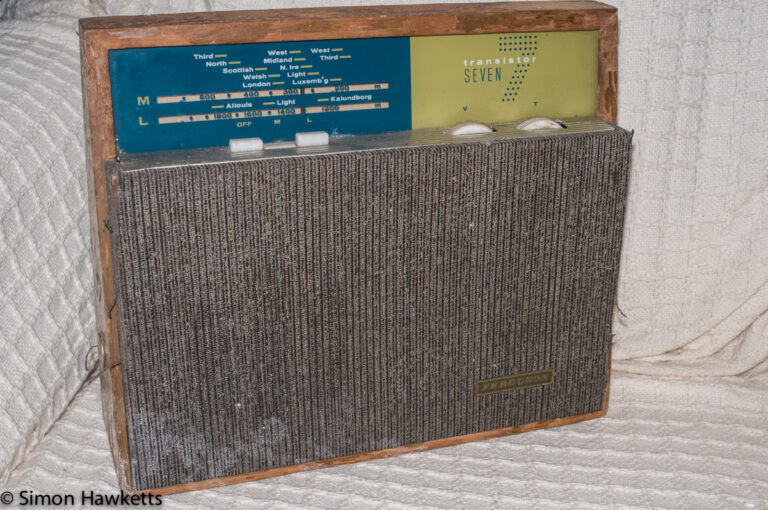Repair of an interesting Vintage Ferguson radio from 1961
The post follows on from the last post in this series and explains how I went about trying to repair a vintage Ferguson radio that I purchased from eBay UK a few months ago. If you are interested in my initial assessment of the Ferguson radio set, have a look at this post.
My assessment of the problems with the Ferguson radio
The vintage radio had problems in two areas. Firstly, the unit was very beaten up with lots of ingrained dirt and the varnish finish on the case was falling off. Also, the speaker cover material and the similar material which covered the back panel of the unit was ripped and peeling.
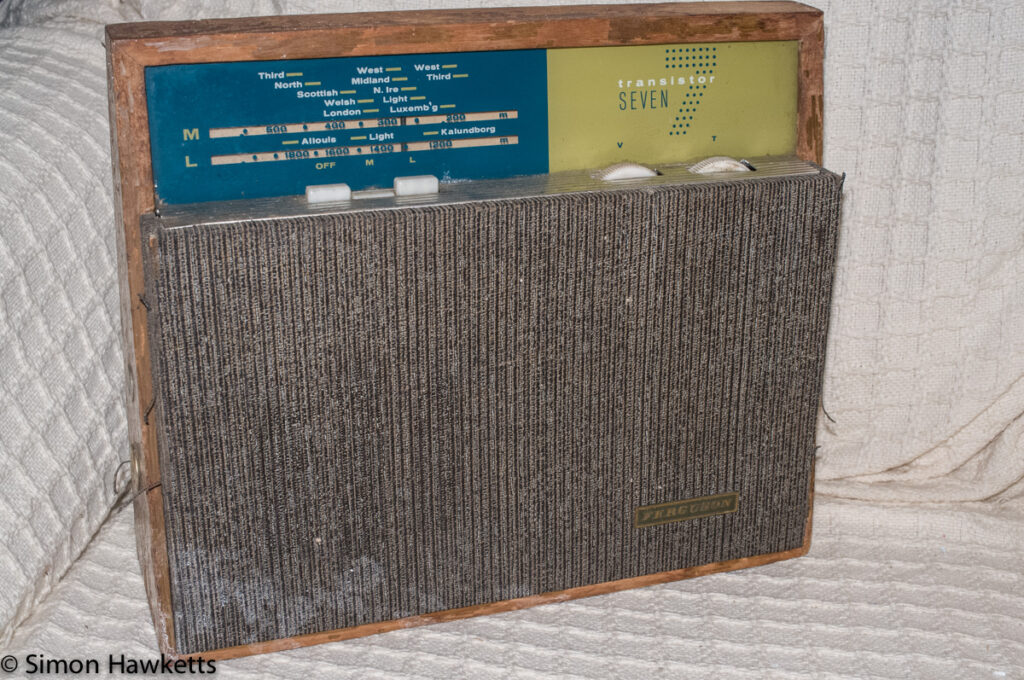
As well as the cosmetic problems, the radio also didn’t work when I connected a battery to it.
I suspected that the electrical problems would be connected to the use of AF117 transistors, which are notorious for forming internal short circuits as the material used for the casing grows ‘whiskers’ which reach the internal connections of the transistor and make the unit fail.
As it happens, once I’d found the initial fault mechanism, the AF117s in my radio seem to be OK – at least for the moment.
Fixing the cosmetic issues of my Ferguson vintage radio
I decided to start the refurbishment and repair of the Ferguson radio by looking at the cosmetic issues.
Dealing with these issues basically involved fully dismantling the radio, removing the electronics from the case and then dismantling the case, cleaning everything and then re-varnishing the wooden case components and recovering the front and back with a new material.
The case came apart without too much trouble. I found the front panel was held in with a few obvious screws in the sides and bottom, and once I removed them I could tap the front out with a small hammer. There was a nice ‘Ferguson’ badge fitted to the front panel which was held in place with two bent ‘prongs’ and that could be removed by bending the prongs out and pulling the badge off the front. I cleaned the badge up with some Brasso, and it came up rather nicely.
I’d originally intended to try to clean and re-stick the material on the front and back panels, but this proved to be unsuccessful. Although I cleaned the material with a damp sponge, it still looked grimy, so I decided to remove it completely and replace it with a new light grey speaker material made for modern Hi-Fi speakers((I know this isn’t a true, vintage radio ‘restorers’ path, but trying to buy genuine speaker material proved to be ridiculously expensive, and the set isn’t worth it)).

Although this did the job, it’s not ideal. The original material was very thin, probably about 1 mm thick, but the modern material I bought consisted of three layers with a central core of foam. This made the whole material about 3 mm, so although it sticks well and covered the front and back it was difficult to fit into corners without some of the bulk showing.
I think for any future restoration, I’ll try to find a thinner material that is better suited to the job.
The case is made from plywood, with a varnished finish which was falling off, so I sanded it down with a medium grade sandpaper, and then applied three coats of a medium oak varnish to the wood, sanding it lightly between each coat.
With the front and back covered with the new material I fitted the front back onto the case and turned my attention to the electronics to find out why the radio didn’t work.
Fixing the electrical issues with my Ferguson vintage radio
As I said in the original article, I’d tried connecting a PP9 to the terminals on the radio and found it to be completely dead. So, I tried reconnecting with an DVM set to DC current in series to see if the radio was drawing any current. When I did this I found it was taking about 80 mA, which is actually quite a lot because the service manual (well the Radio & TV servicing manual for 1962/63 which has the Ferguson set in it on page 130), says that it should take about 20 mA for normal output.
Whilst the set was connected to the battery I had a poke around and found that if I touched the input to the audio board, I could hear a hum from the loudspeaker. This suggested that the audio part of the set was working, or at least working enough that I should hear something if the rest of the set could be got to work.
It was whilst poking around with the IF board that I found it was possible to get some sort of crackling noise from the set when I flexed the board a bit, which led me to look at all the joints on the bottom in case there was a dry joint. Although I couldn’t find any problem with joints, whilst I was giving the board a good look over I found one of the resistors had its end cap broken away from the body.

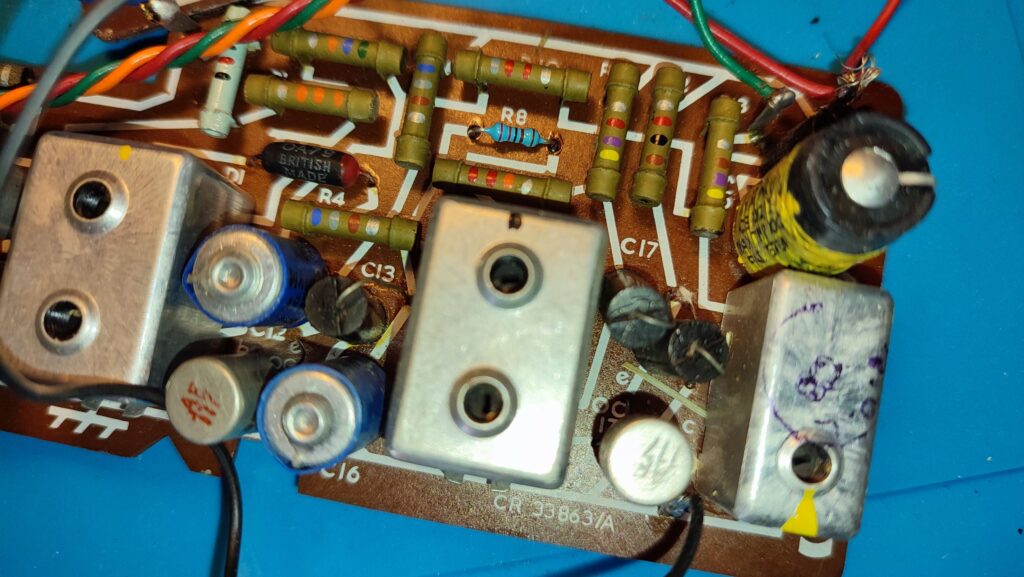
The broken resistor is R8 and when I looked on the circuit I found that it’s a 2.2k resistor in the collector circuit of the first IF amplifier (actually, I could see it was 2.2k because it had 3 red bands on it i.e. 2 2 and 2 x 0).
I replaced the broken resistor with a modern replacement1 and found that there was then life in the radio, although the volume was very low.
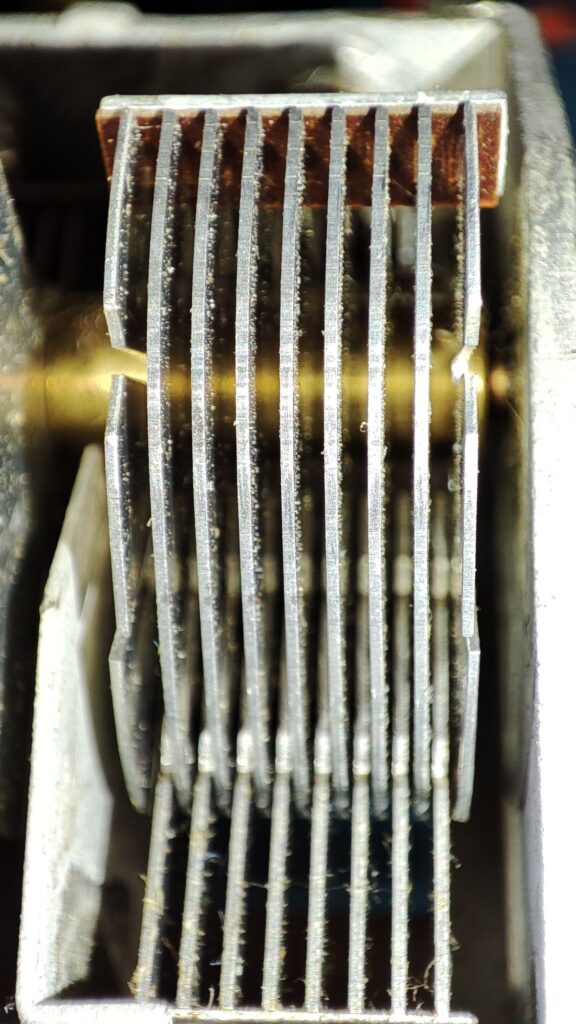
With a bit more poking around, I found a capacitor on the same board was also broken. This capacitor, marked as C22 on the circuit, feeds the volume control and the AGC circuit, so it looked a good candidate for a component that would cause a very low signal level. Unfortunately, I didn’t have any capacitors with the correct value (0.01uF), so I had to wait until I could get some to replace it, but when I did that I found it actually made no difference to the volume level.
It was at this point that I hooked an oscilloscope up to the board and found that the local oscillator stopped working at various points along the medium wave band as I tuned the set((It actually must have also been failing on the long wave band, but I didn’t try it)).
After inspection of the main tuning capacitor, I found that the plates were distorted and touching at a couple of points. Some careful manipulation of the plates stopped this and the set would then tune across the full scale and work, although I could only pick up a couple of the strongest stations.
With the set tuned to the strongest signal I could find, I started making some signal measurements and found that on the collector of the final IF stage I had a pretty decent signal level of a couple of volts of modulated IF. This stage feeds into the demodulator and the demodulated output is used to feed both the volume control, and the AGC line back to the mixer / oscillator stage.
On the demodulated output I had virtually no signal, so I deduced that this was the point where the signal was failing.
The demodulator diode is housed inside the casing of the final IF transformer, so to try to diagnose the problem I de-soldered the final transformer and removed the aluminium case. Interestingly, when I tried the set without the transformer fitted I found the signal level remained just about the same, so I’m fairly confident the fault lies within the final transformer / demodulator.
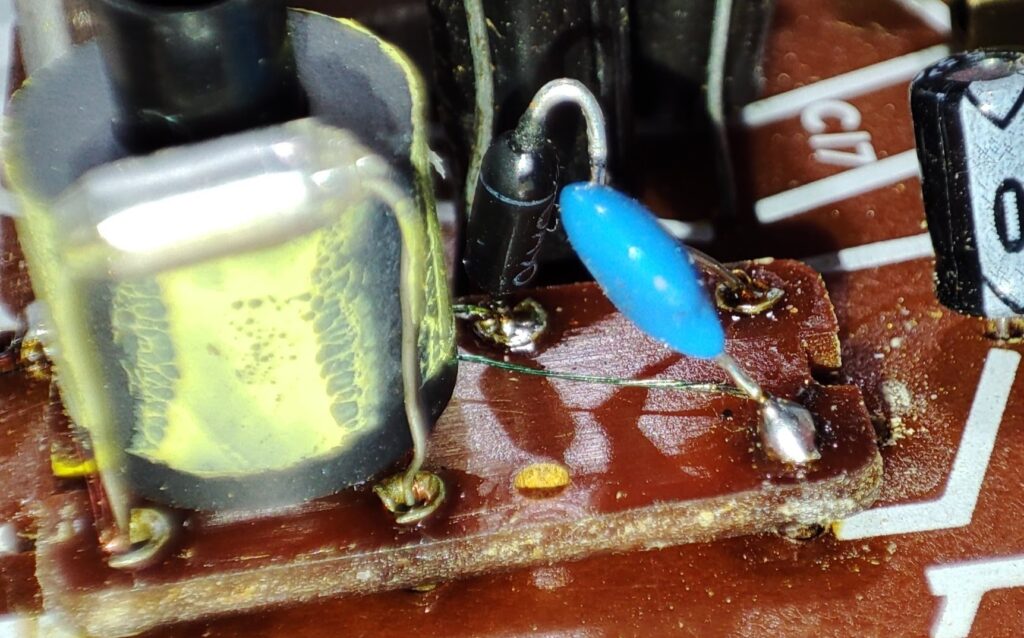
The photo here shows the transformer after I refitted it to the radio. I’d replaced one of the components, a 10 nF capacitor, because when I tried to unsolder it to measure it, the case fell apart, but that wasn’t the guilty component.
In fact, I couldn’t get the set fixed.
On the circuit diagram, the primary is marked as being 3 ohms, and the secondary is 3.3 ohms. I found the primary measured about 4.2 ohms, and the secondary about 0.8 ohms, so I believe the secondary has either a short across it, or some shorted turns. I couldn’t find a strand of wire across the secondary, so I deduced that it must be an internal short between the turns.
Unfortunately, that sort of component is very difficult to get a replacement for unless you have another copy of the same radio, or at least one made by the same manufacturer made at a similar time which might have the same component fitted. Therefore, for the time being, this radio is waiting for a donor model that I can use to find a replacement IF transformer.
Conclusion of repair attempt.
So in this case I’ve not been able to get the radio completely fixed. However, I don’t think the attempt has been a failure.
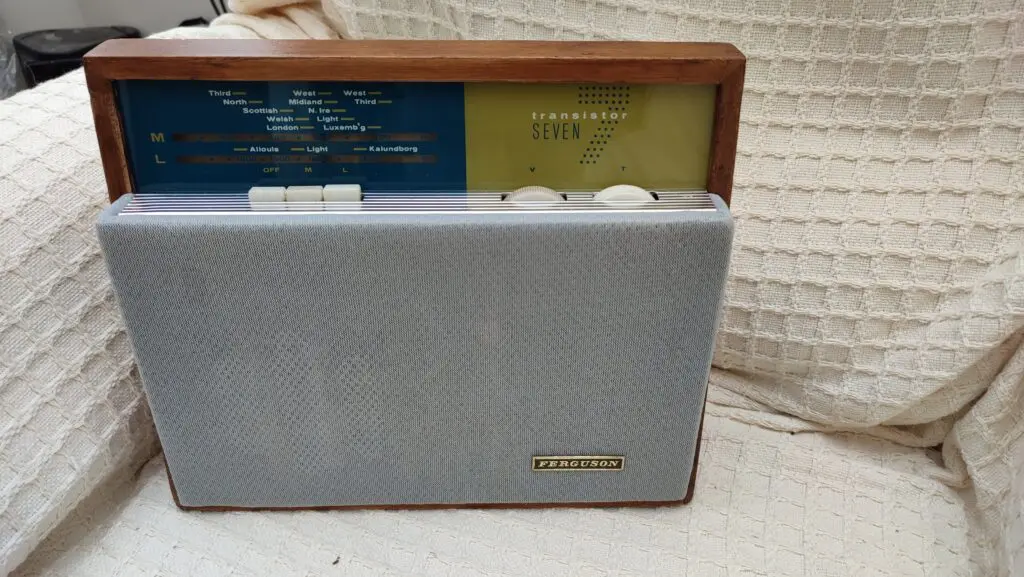
For a start, I’ve learnt – or relearnt – a lot of knowledge in the attempt. I’ve had some practice at reading circuit diagrams, which is something I’ve not done for about 25 years, and reacquainted myself with the use of some test equipment. I’ve also successfully found at least two faults which did result in the set being at least partially working.
I’ve also had a go at some case refurbishment which, although it didn’t result in a finished, improved radio, has taught me some skill that I’ll use in the next radio I refurbish.
- I know a lot of vintage radio enthusiasts would balk at that and say that traditional components should be used. The problem with that is 1) I don’t have any replacement traditional components and 2) if you find a replacement from another radio what’s to say it won’t also fail in a few weeks or months [↩]
Discover more from Everything Vintage
Subscribe to get the latest posts sent to your email.




